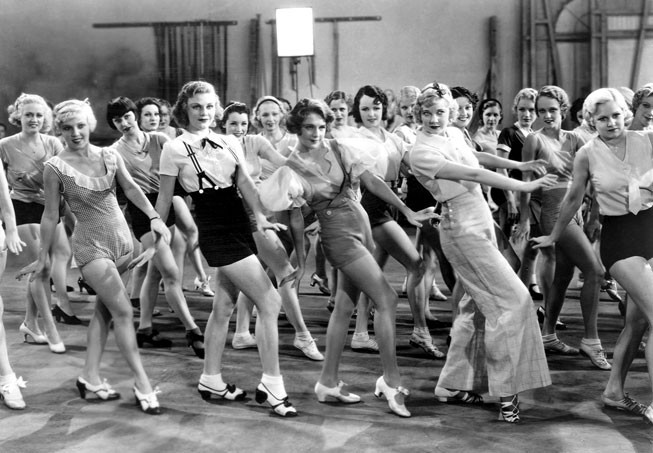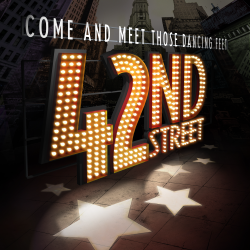Support the Free Press | Facts matter. Truth matters. Journalism matters
Salt Lake City Weekly has been Utah's source of independent news and in-depth journalism since 1984. Donate today to ensure the legacy continues.
Thursday, September 24, 2015
42nd Street: Broadway Does Berkeley
42nd Street runs Sept. 22-27 at Capitol Theatre, 50 W. 200 South.
Posted By Brandon Burt on September 24, 2015, 3:11 PM
There are so many things that are right about 42nd Street—as well as a few things that are bemusing about its current Broadway Across America touring production.
Oh, the production itself is terrific, never mind about that. A feast for the eyes and ears, a triumph the whole family can enjoy.
And when, in this day and age, do we ever get to see tap-dancing that isn’t an ironic commentary about “tap-dancing,” or an observation about the tap-dancer’s experience, or a silly throwaway joke? Because if it seems spending years to learn the paddle roll, paradiddle, shim sham shimmy and the double-trip Maxie Ford with a Knickerbocker break is as useful an endeavor as learning to tie balloon animals with your ears, you haven’t seen this production’s show-stopping, expertly executed title production number toward the end of Act II.
Of course, with this show, the choreography’s the thing. 42nd Street is as much a tribute to Busby Berkeley’s trippy Depression-era Hollywood musicals as it is to Harry Warren and Al Dubin’s bright, urbane songs that inspired Berkeley’s choreography and camera direction to such dizzy heights. Berkeley seems to be the first Hollywood choreographer to realize it’s possible to do more with a camera than simply point it at a stage. He’s the one, for instance, who invented that whole “chorus-girl kaleidoscope” effect that's become such a part of the cultural landscape that even those unfamiliar with the genre recognize it.
Any stage production would be hard set to effectively tip its hat to Berkeley. What would it take? Digital screen projections? A giant mirror angled at 45 degrees above the stage? So it seemed mysterious how a traveling production—whose set must be flat-packed all around the country in a finite number of semi-trailers—could pull it off.
Nicely, as it turns out. At the end of Act I, Scene 1, “Shadow Waltz”—which, by the way, is one of Berkeley’s most deliriously wacky numbers as it appeared in Gold Diggers of 1933, with the entire chorus playing neon violins and then arranging themselves in a giant violin-shaped formation—showed that all it took was some strategically placed lights, a plain white scrim and a good sense of humor. (Watch from about 3:10 of the following clip.)
As for the songs, well, the creators had Warren & Dubin’s entire oeuvre to choose from. So, needless to say—although this is no jukebox musical—it’s one of those rare shows in which every last number is a hit.
The bemusing thing about it is simply: What makes the producers think today’s audiences will “get” 42nd Street? The only people who watch 1930s Hollywood musicals are geeks, stoners and octogenarians. What is the audience to think of such a freak show with such a simple, gentle arc and songs that many people tend to associate with Saturday-morning cartoons?
Okay, so the production goes broad. (And when you go broad with a 1930s musical script, that’s broad.) These are professionals playing to middle-America, and they know that audiences out here will laugh when they’re told to, as long as the joke is delivered as deliberately as possible. After all, they came all this way to entertain us—it would be impolite not to laugh!
The problem is, the sparkling dialogue loses so much when it’s delivered the same way you might play a middle-school assembly. Because those movies, well, sure they were chirpy and optimistic and daffy and kind of simple. But it’s not because the moviegoing audiences of the time were stupid. Yes, people did want to escape from the despair of the Great Depression. But it wouldn’t have worked if these movies talked down to their audiences. There was always an undertone of cynicism. It was bright, crackling kind of cynicism—not inspired so much by degradation and ennui as by a fatalistic sort of survival instinct.
That’s what’s missing from much of this show, at least in Act I. (The cheerfully giddy “Shuffle Off to Buffalo”—which contains its own built-in cynical take on newlyweds—oddly seems to help the cast find its edge.)
But perhaps this is more a criticism of audiences than it is of the production. Or, perhaps, it’s really more of a criticism of myself: Because I’m so out-of-step, I still consider this show and those old Hollywood musicals to be more than mere entertainment. They contain a sensibility and a certain kind of creative outlook that still has a lot to say to the world today—if the world has ears to listen.
Oh, the production itself is terrific, never mind about that. A feast for the eyes and ears, a triumph the whole family can enjoy.
And when, in this day and age, do we ever get to see tap-dancing that isn’t an ironic commentary about “tap-dancing,” or an observation about the tap-dancer’s experience, or a silly throwaway joke? Because if it seems spending years to learn the paddle roll, paradiddle, shim sham shimmy and the double-trip Maxie Ford with a Knickerbocker break is as useful an endeavor as learning to tie balloon animals with your ears, you haven’t seen this production’s show-stopping, expertly executed title production number toward the end of Act II.
Of course, with this show, the choreography’s the thing. 42nd Street is as much a tribute to Busby Berkeley’s trippy Depression-era Hollywood musicals as it is to Harry Warren and Al Dubin’s bright, urbane songs that inspired Berkeley’s choreography and camera direction to such dizzy heights. Berkeley seems to be the first Hollywood choreographer to realize it’s possible to do more with a camera than simply point it at a stage. He’s the one, for instance, who invented that whole “chorus-girl kaleidoscope” effect that's become such a part of the cultural landscape that even those unfamiliar with the genre recognize it.
Any stage production would be hard set to effectively tip its hat to Berkeley. What would it take? Digital screen projections? A giant mirror angled at 45 degrees above the stage? So it seemed mysterious how a traveling production—whose set must be flat-packed all around the country in a finite number of semi-trailers—could pull it off.
Nicely, as it turns out. At the end of Act I, Scene 1, “Shadow Waltz”—which, by the way, is one of Berkeley’s most deliriously wacky numbers as it appeared in Gold Diggers of 1933, with the entire chorus playing neon violins and then arranging themselves in a giant violin-shaped formation—showed that all it took was some strategically placed lights, a plain white scrim and a good sense of humor. (Watch from about 3:10 of the following clip.)
As for the songs, well, the creators had Warren & Dubin’s entire oeuvre to choose from. So, needless to say—although this is no jukebox musical—it’s one of those rare shows in which every last number is a hit.
The bemusing thing about it is simply: What makes the producers think today’s audiences will “get” 42nd Street? The only people who watch 1930s Hollywood musicals are geeks, stoners and octogenarians. What is the audience to think of such a freak show with such a simple, gentle arc and songs that many people tend to associate with Saturday-morning cartoons?
Okay, so the production goes broad. (And when you go broad with a 1930s musical script, that’s broad.) These are professionals playing to middle-America, and they know that audiences out here will laugh when they’re told to, as long as the joke is delivered as deliberately as possible. After all, they came all this way to entertain us—it would be impolite not to laugh!
The problem is, the sparkling dialogue loses so much when it’s delivered the same way you might play a middle-school assembly. Because those movies, well, sure they were chirpy and optimistic and daffy and kind of simple. But it’s not because the moviegoing audiences of the time were stupid. Yes, people did want to escape from the despair of the Great Depression. But it wouldn’t have worked if these movies talked down to their audiences. There was always an undertone of cynicism. It was bright, crackling kind of cynicism—not inspired so much by degradation and ennui as by a fatalistic sort of survival instinct.
That’s what’s missing from much of this show, at least in Act I. (The cheerfully giddy “Shuffle Off to Buffalo”—which contains its own built-in cynical take on newlyweds—oddly seems to help the cast find its edge.)
But perhaps this is more a criticism of audiences than it is of the production. Or, perhaps, it’s really more of a criticism of myself: Because I’m so out-of-step, I still consider this show and those old Hollywood musicals to be more than mere entertainment. They contain a sensibility and a certain kind of creative outlook that still has a lot to say to the world today—if the world has ears to listen.
On Topic...
-
Film Reviews: New Releases for April 19
The Ministry of Ungentlemanly Warfare, Abigail, The Beast, Hard Miles, Sasquatch Sunset and more
- Apr 19, 2024
-
Film Reviews: New Releases for April 12
Civil War, Escape from Germany, Coup de Chance, Hundreds of Beavers, La Chimera, Sting
- Apr 11, 2024
-
Film Reviews: New Releases for April 5
Monkey Man, The First Omen, Wicked Little Letters, Girls State, Scoop, Exhuma
- Apr 4, 2024
- More A&E » More Culture »
More by Brandon Burt
-
Utah Republican Has Moment of Sanity
Utah GOP's MLK Day Press Release Uncharacteristically Devoid of Deranged Commentary; Concerned Constituents Puzzled
- Jan 18, 2016
-
MLK Day 2016 Celebration Rally & Marade
- Jan 18, 2016
-
This holiday has been brought to you by the letter 'X'
Xmas, Christmas and exotic alphabets
- Dec 23, 2015
- More »







